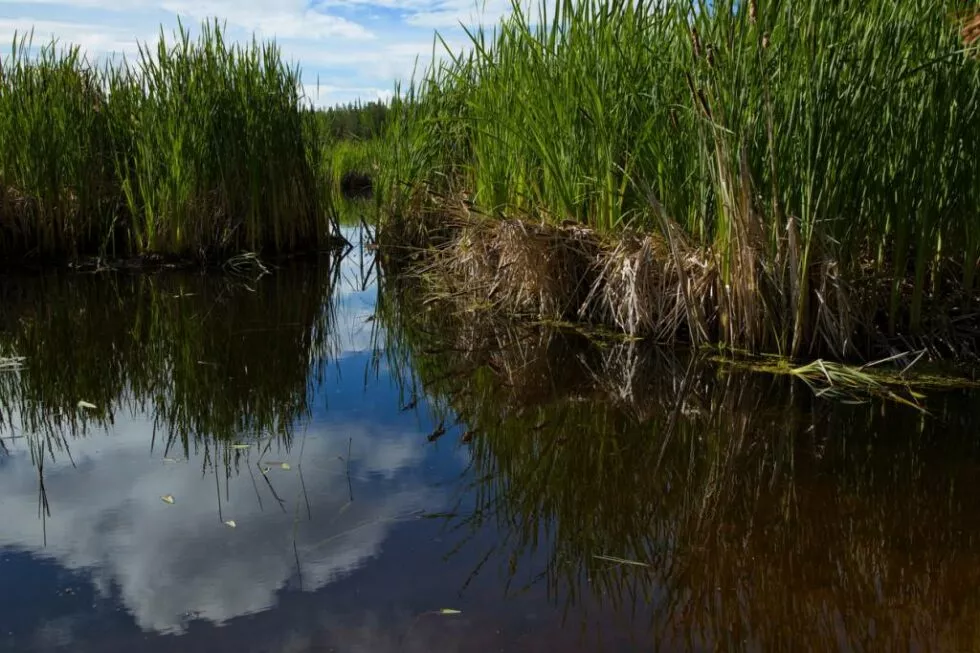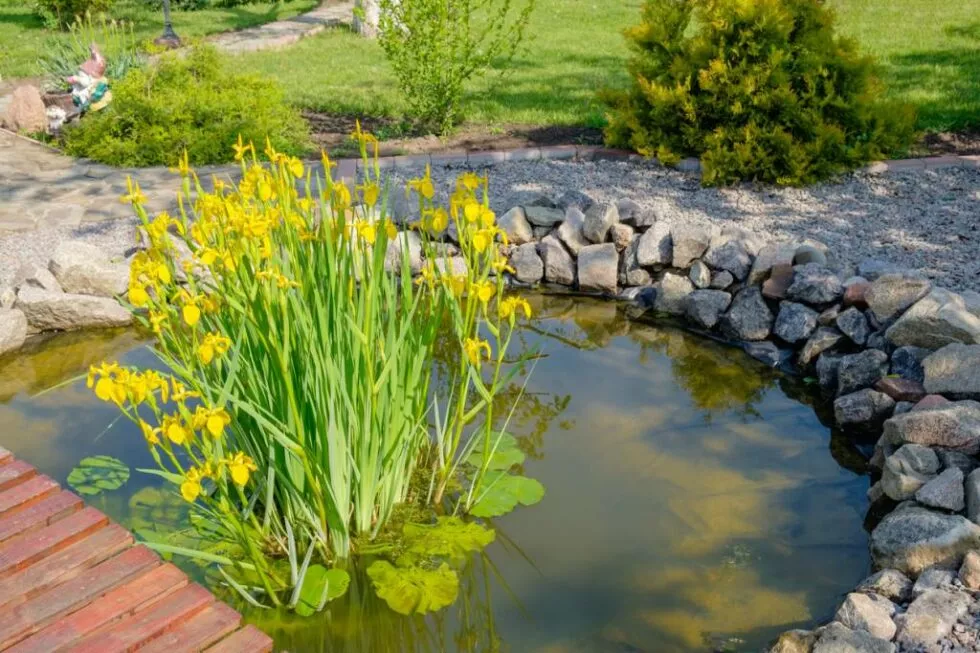The best plants for the phyto-purification of wastewater
The choice of aquatic or semi-aquatic plants for the wastewater phyto-purification filters is not random, in order to obtain an optimal level of purification. Not all plant species have the same root structure or the same capacity to absorb nitrates, phosphates or heavy metals. Which plants should you choose to ensure high-quality purification in your effluent treatment basin? Aquatiris, the French leader in phyto-purification wastewater treatment solutions, can help you decide.
Reeds, an essential part of phyto-purification systems
Thanks to their impressive capacity for filtering and depolluting dirty water, common reed is used to make Aquatiris’s single-stage treatment systems. When properly designed, phragmites can equal or exceed the performance of a dispersal system and sand filters in terms of wastewater treatment. The effluents recycled in an all-water septic tank is possibly routed to a pre-filter before reaching the reed planted filter to finalise the phyto-purification process.
The phragmite planted filter is also used for pre-treatment in the two-stage phyto-purification system that we offer. Adapting easily to most soils, this species is one of the best aquatic filtering plants for individual ecological wastewater treatment.

Phragmites australis, the most commonly used species for phyto-purification
Phragmites australis, or common reed, is widely used for phyto-purification because these plants can quickly develop a very dense filtering root system. It is an invasive species that grows by spreading its seeds and activating a powerful network of horizontal rhizomes. These can have a diameter of up to 2cm. Each common reed can develop around a hundred stems per square metre in the natural wastewater treatment basin.
Belonging to the Poaceae family, Phragmites Australis can reach a height of 4 metres at their maximum point of development. They are mainly found in wetlands in countries with a temperate climate. These aquatic plants with robust stems can withstand temporary periods of drought. Phragmites can also withstand temperatures as low as -25⁰C. Thanks to their attractive yellow-striped green variegated foliage, these plants turn your ecological individual sanitation system into a plant-based decoration for the outdoor space. In a vertical filter with sand and gravel, Phragmites australis can develop their roots up to 60 or 80cm deep. This depends on the humidity conditions and the availability of nutritious organic matter.
In the Sanitation Garden, the powerful rhizomatous root system of these aquatic phyto-purification plants enables them to capture a large part of the suspended matter in the water. The nitrates and phosphates resulting from the degradation of organic matter are partly used by the phragmites reeds to maintain their growth. The growth dynamics of the Phragmites australis water plants also prevents soil clogging while guaranteeing optimal oxygenation of aerobic bacteria. The dense rhizomatous system of the common reed also facilitates good water infiltration in the natural wastewater treatment basin.
Maintenance of the phyto-purification system
Reed planted filters require very little maintenance compared to other available phyto-purification filters. It is sufficient to ensure that the filtration system is always supplied with dirty water, particularly during periods of drought when the plant roots are not yet well developed. During the first three years of the aquatic filtering plant’s life, weeds that can prevent it from growing properly must also be removed. The proliferation of these weeds can also partially clog the planted filter. To make the effectiveness of phyto-purification sustainable, the ecological wastewater treatment basin must be cleaned on average every 10 years.
Iris plants combine phyto-purification and garden decoration
The Sanitation Garden of the Iris range, manufactured by Aquatiris, provides a decorative flowery filter at the end of the polluted water course. The dominant aquatic filtering plant in this flowery purification system is the Iris pseudacorus or marsh iris. Its optimum density in a phyto-purification system is 4 plants per square metre. In the wild, this plant, which is permanently submerged, is generally found in ponds, streams, ditches and near banks. This semi-evergreen species from the Iridaceae family is easily recognisable by its large, decorative yellow flowers. At the time of flowering, the marsh iris can grow to a height of 1.2 metres.
In an individual effluent phyto-purification system, the ideal water depth for good root development of the common iris varies between 10 and 35cm. This vigorous filtering plant is highly resistant to low temperatures (down to -28⁰C). Its properties for filtering and depolluting polluted water are very interesting, even if they do not equal those of Phragmites australis. Common reed breaks down large organic pollutants thanks to the aerobic bacteria in its root system.
After this treatment stage in the iris planted filter, the water still contains excess nitrates or phosphates. Infectious biological agents may also be present. This population of chemical and biological substances is a nutrient resource for the marsh iris plants in your ecological individual effluent treatment system.

Carex, another essential part of phyto-purification
Our filters planted with sedges contain two main purifying plant species: Carex acutiformis (common sedge) and Carex riparia (riverside sedge). These plants are generally used in the second stage of wastewater treatment in the phyto-purification systems offered by Aquatiris.
Carex acutiformis
Belonging to the Cyperaceae family, the common sedge is an ornamental grass native to Europe. In the wild, Carex acutiformis is found in marshes, swamps, ponds, pools and even basins, generally between sea level and an altitude of 1300 metres. It is a filtering aquatic plant and perennial with a spiky silhouette, with an average height of between 50 and 120cm.
It has scabrous linear leaves with a sharp edge. In the effluent treatment system, Carex acutiformis grows quite quickly thanks to its significant stoloniferous and rhizomatous strain. This plant for the natural purification of effluents requires no maintenance and can withstand low temperatures down to -15°C.
Carex riparia
This species of Carex is distinguished from others by its scabrous, trigonous stems and its long, broad, sharp leaves. It is a semi-aquatic filtering plant with bluish evergreen foliage that is found on the banks (streams, rivers, etc.) in the natural environment. Also present in wetlands, Carex riparia grows best in loamy soil. Like Carex acutiformis, it can be planted to hold back the banks.
The riverbank sedge is an essential element of the ornamental plant filters that our specialised company manufactures. To properly capture biological and chemical matter, the distance between the plant’s rhizome system and the surface of the water should ideally not exceed 10cm. Riverbank sedges are hardy (down to -22°C). For the purification of polluted water using phyto-purification, we recommend the use of 6 to 8 plants per square metre in the Carex planted filter.
Fragrant water mint
A member of the Lamiaceae family, Mentha aquatica L. is an excellent aquatic filtering plant. We generally integrate it into the Carex Sanitation Garden and the planted filter of the Iris range. In its adult stage, the water mint can reach a height of 50cm. It can withstand harsh winters where the temperature can drop to -28°C. This highly fragrant perennial species grows in shallow water (between 0 and 20cm deep). This perennial that grows along riverbanks has honey-bearing mauve-pink flowers and green leaves edged with red.
It is highly prized for its remarkable decorative properties in the composition of planted flower filters. In the individual natural sanitation system, a density of 4 to 6 specimens per m² is generally recommended by experts from Aquatiris. To maintain this reference species in phyto-purification, all that is required is to cut the dry, flowerless stems of the plant in the spring.
The beautiful purple loosestrife
Widely used in phyto-purification, Lythrum salicaria is found naturally in marshy or damp environments, ponds or along waterways. The root system of this semi-aquatic plant species captures the nitrates and phosphorus contained in the water already treated at the previous filters. This perennial plant is recognisable by its deciduous foliage and long spikes of purple-pink flowers. It grows to a large size, varying between 1 and 1.5m. Our company includes common loosestrife in the Sanitation Gardens of the Iris and Carex ranges.
Combined with Iris pseudacorus, purple loosestrife brings colour to the filter and will embellish your outdoor space. This ornamental species grows quickly in moist or marshy soil and can withstand low temperatures of between -23 and -28°C. The distance between the plant’s root system and the surface of the water should ideally vary between 0 and 25cm. To optimise the absorption of nutrients without preventing the proper growth of plants, a density of 3 to 6 specimens per square metre is chosen for our natural wastewater treatment solutions.


